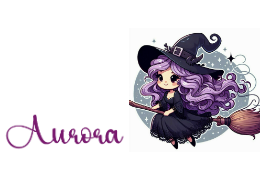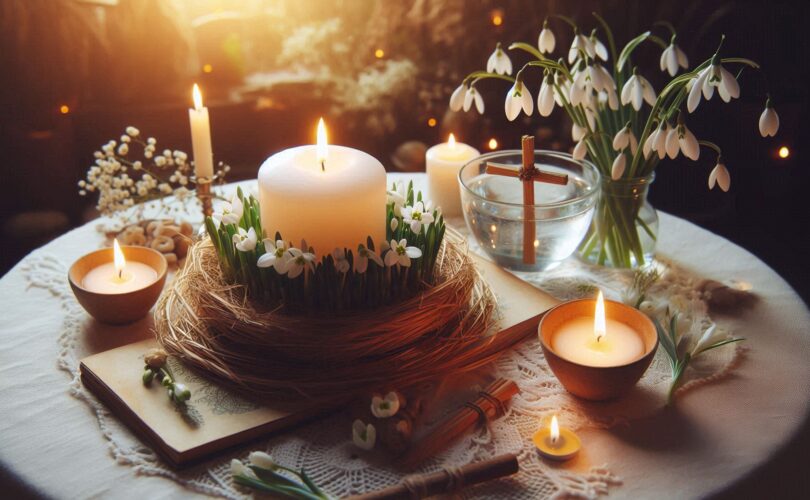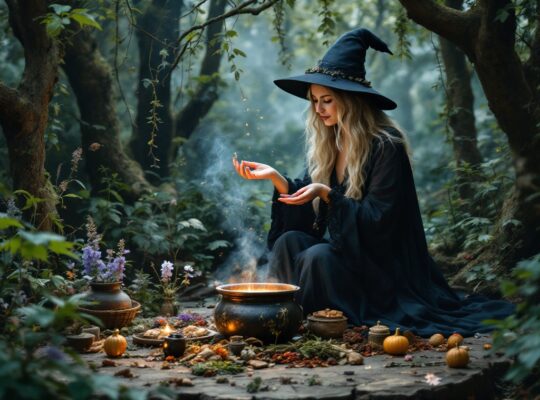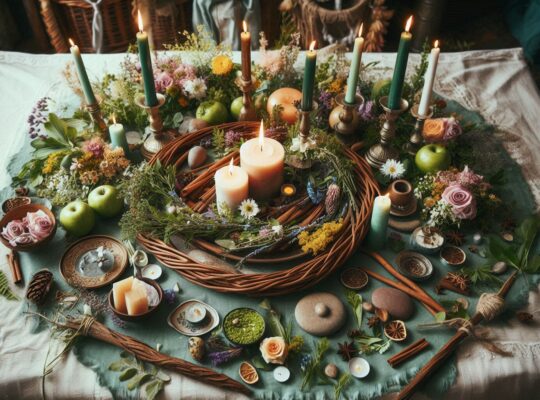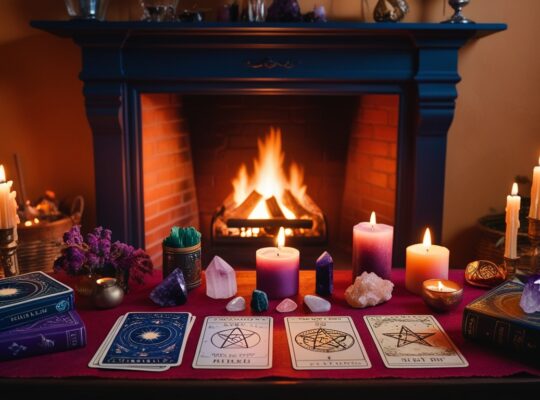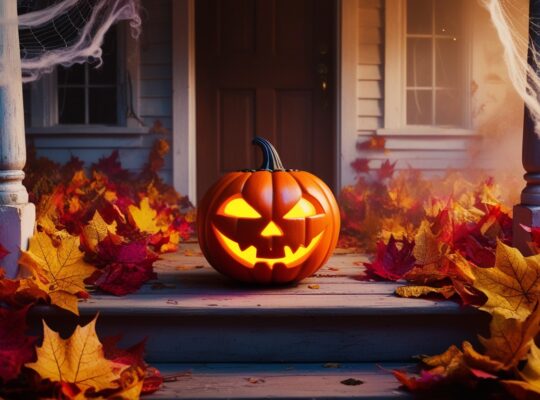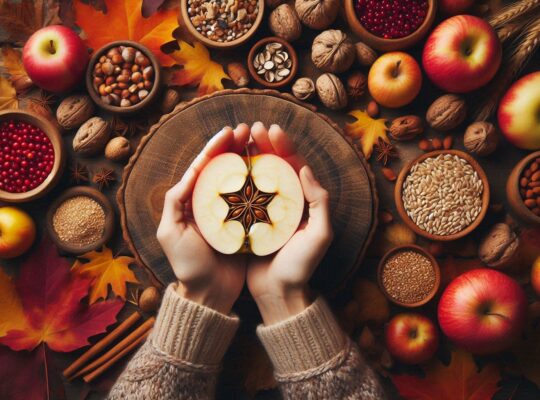Imbolc’s Healing Light: Celebrating the First Stirrings of Spring
As winter’s deepest chill begins to soften and the first tiny signs of life emerge from beneath the snow, the Wheel of the Year turns to welcome Imbolc, a celebration of hope, purification, and the gentle awakening of the earth. This special time honors the barely visible but powerful stirrings of new life that promise spring’s eventual return. Imbolc invites us to kindle our inner flame, cleanse our spirits after winter’s heaviness, and nurture the seeds of healing that will grow in the seasons ahead. In this guide, we’ll explore simple ways to bring Imbolc’s gentle energy into your life with rituals that honor both winter’s wisdom and spring’s promise.
When Imbolc’s First Light Appears
Imbolc arrives each year on February 1st-2nd in the Northern Hemisphere. In 2026, we’ll celebrate on Monday, February 2nd. This meaningful holiday marks the midpoint between Winter Solstice (Yule) and Spring Equinox (Ostara), when the first subtle signs of spring begin to appear even though winter still holds the land.
After Yule’s deep winter stillness, Imbolc brings us the first whispers of awakening—perhaps a patch of melting snow, early bulbs pushing through frozen ground, or the slight strengthening of sunlight. The name “Imbolc” comes from Celtic traditions, meaning “in the belly” or “ewe’s milk,” referring to the pregnancy of sheep and the first milk that signals lambing season ahead.
Traditional celebrations honored this time with candle ceremonies, home purification rituals, and invocations to Brigid (also spelled Brighid or Bride), the Celtic goddess of healing, poetry, and smithcraft whose flame helps spark life’s return. Christians later adapted these celebrations as Candlemas, maintaining the connection to light and purification.
Imbolc teaches us about hope during challenging times—how to recognize and nurture the smallest signs of healing and growth. This makes it perfect for gentle practices that honor both our need for continued winter rest and our readiness to plant seeds for spring renewal.
Ancient Wisdom of Imbolc
For thousands of years, people living close to the land recognized this subtle turning point in the year’s cycle. Our ancestors understood that while winter still gripped the outer world, life was already stirring beneath the surface, preparing for spring’s eventual arrival.
In Celtic traditions, Imbolc was associated with the goddess Brigid, whose name means “Exalted One.” She embodies the triple aspects of healing, creativity, and transformation—skills especially needed during late winter when resources grew scarce and illness threatened communities. People would make Brigid’s crosses from rushes or straw as protective talismans and leave offerings for the goddess to ensure her blessings during the coming growing season.
Farmers would watch for signs like the emergence of the groundhog or serpent from their winter homes, believing these creatures could predict whether spring would come early or late. These observations became the foundation for modern traditions like Groundhog Day that coincide with Imbolc.
Many Imbolc customs involved purification—cleaning homes thoroughly, burning old Yule greens, and ritually cleansing body and spirit—recognizing that creating clean space allows new growth to flourish. These ancient practices remind us that clearing away what no longer serves us creates room for healing and fresh energy.
When we celebrate Imbolc today, we join this long lineage of people who found hope in winter’s waning days. Their simple wisdom teaches us that even when outer circumstances seem unchanged, transformation is already underway beneath the surface.
Imbolc’s Special Symbols
Imbolc gives us meaningful symbols that connect us to this season of subtle awakening. Candles represent the returning light and the sacred flame of inspiration, healing, and creativity associated with Brigid. Lighting candles at Imbolc connects us to the strengthening sun and our own inner flame that sustains us through winter’s final weeks.
Snowdrops, crocuses, and other early spring flowers embody hope and resilience—delicate blooms that push through frozen earth to claim their place in the light. These first flowers remind us that tender beginnings often require the greatest courage and that healing frequently starts with small, barely visible changes.
Brigid’s cross, traditionally made from rushes or straw, creates a protective symbol associated with the goddess’s blessing. The simple act of weaving these crosses connects us to ancestral wisdom while creating talismans that invite healing and inspiration into our homes.
Lambs and ewes represent new life and nourishment, reflecting the original meaning of Imbolc as the time when sheep begin lactating before giving birth. This symbol reminds us that nurturing ourselves and others creates the foundation for healthy growth and development.
Seeds hold special meaning at Imbolc as repositories of potential waiting for the right conditions to sprout. Holding seeds during Imbolc rituals connects us to our own dormant possibilities that need only proper care and timing to flourish.
Simple Imbolc Rituals for Healing
Creating a candle blessing ritual offers a beautiful way to connect with Imbolc’s returning light. Gather several candles of white, red, or green (colors associated with Brigid and healing). As you light each one, speak a blessing for an area of your life where you seek renewal or healing. This simple practice acknowledges both the growing outer light and your inner flame that sustains you through difficult times.
A home cleansing ceremony honors Imbolc’s traditional focus on purification. Open windows briefly (even in cold weather) to allow fresh air to circulate. Sweep your home from back to front, visualizing winter’s stagnant energy being cleared away. Sprinkle salt water in corners for purification or spray a homemade cleansing mist of water with a few drops of purifying essential oils like rosemary, lemon, or pine.
Making a Brigid’s cross from natural materials connects you to traditional Imbolc crafts while creating a protective symbol for your home. Using rushes, straw, or even pipe cleaners, weave a simple cross design (tutorials can be found online). As you create this ancient symbol, infuse it with intentions for protection and healing throughout the coming year.
The seed blessing ritual helps clarify what you wish to grow in your life. Hold actual seeds in your hands (any type will work), warming them with your breath while visualizing your intentions for the coming season. What healing, growth, or change do you wish to nurture? Plant these seeds in a small pot of soil, tending them as a living symbol of your developing intentions.
Healing Plants of Imbolc
As winter begins its gradual release, certain plants offer special healing benefits:
- Snowdrops reach bravely through snow, making them perfect Imbolc allies for courage during difficult transitions. These delicate white flowers have traditionally symbolized hope and the return of light. While not typically used medicinally, keeping snowdrop bulbs or images on your altar connects you to their resilient spirit.
- Angelica begins its second-year growth around Imbolc in many regions, offering protection and strength. Its hollow stem was traditionally associated with the movement of spirit and healing energy. A tea made from dried angelica root (when ethically sourced) supports respiratory health during winter’s final weeks.
- Blackthorn blossoms earliest among trees, often flowering while its branches remain bare of leaves. This protective tree teaches us about finding beauty even before full growth returns. Sitting with blackthorn or bringing a few mindfully gathered blossoms to your altar connects you to this guardian energy.
- Rosemary remains evergreen through winter, offering memory support and purification. This hearth-protecting herb has long associations with Brigid and cleansing rituals. Burning dried rosemary as incense helps clear stagnant energy from your home, while using it in cooking brings both flavor and subtle healing properties to Imbolc meals.
- Calendula’s sunny flowers can be dried from last season’s harvest, bringing solar energy into late winter. These gentle healing flowers support skin health and immune function. An oil infused with calendula brings the promise of sunshine even when skies remain gray, while calendula tea offers mild support for winter wellness.
Creating Your Imbolc Altar
Your Imbolc altar becomes a focal point for this season of quickening energy—a sacred space where winter’s wisdom meets spring’s promise. Create this space with mindful presence, letting your heart guide what feels right.
Candles form the heart of a traditional Imbolc altar—white for purity, red for life’s fire, or green for healing and growth. Arrange them safely, perhaps in a spiral pattern symbolizing the gradual return of light or in a triangle honoring Brigid’s triple aspects of healing, poetry, and smithcraft.
Early spring flowers like snowdrops or crocuses bring living beauty and hope. If these aren’t available in your area, pussy willow branches or forced bulbs growing indoors can represent nature’s awakening. Even images or drawings of these early bloomers connect you to the season’s energy.
Seeds and garden tools in miniature honor Imbolc’s connection to preparation for the growing season. Placing these on your altar helps crystallize your intentions for what you wish to cultivate in the coming months—both in your garden and in your life.
Symbols of Brigid strengthen your connection to this powerful healing goddess. A small Brigid’s cross, a candle dedicated to her, or a bowl of milk or water as an offering honors her presence. Some traditions include a small cloth left outside on Imbolc Eve for Brigid to bless (called a Brat Bríde), which is then used for healing throughout the year.
White and silver items represent the lingering snow and ice of winter, while touches of green acknowledge the life stirring beneath. This color balance honors the transitional nature of Imbolc—not fully winter anymore, but not yet spring.
Let your altar evolve throughout the Imbolc season, perhaps adding signs of early spring as you notice them on walks—a budding twig, a stone uncovered from melting snow, or a feather from returning birds. This sacred space honors both the quiet wisdom of winter and the whispered promises of spring.
Foods for Imbolc Celebration
Imbolc traditionally honors dairy foods, reflecting the original meaning of the holiday as the time when sheep and other livestock began producing milk again after winter. Creating a meal that features milk, cheese, or yogurt connects you to this ancient association while providing nourishing comfort during late winter.
Seeds and nuts represent the promise of future growth and were traditional Imbolc foods for our ancestors. Incorporating sunflower seeds, pumpkin seeds, or almonds into breads, salads, or simply roasting them with herbs creates tasty, energy-rich foods perfect for this transitional season.
Spicy, warming foods honor Brigid’s flame and help maintain our inner fire as winter continues. Dishes seasoned with ginger, garlic, rosemary, or pepper increase circulation and support immunity during this final stretch of cold weather. A simple ginger tea or soup with warming spices brings both comfort and healing.
Pancakes and crepes hold special meaning at Imbolc, their round golden shape symbolizing the returning sun. Making these simple foods becomes a sacred act when done with intention—perhaps visualizing the growing light as you flip each golden cake. Serving them with honey connects to the sweetness of life returning.
Early spring greens like dandelion, chickweed, or nettles might be appearing in milder climates. These nutritious plants were precious to our ancestors after winter’s limited diet. Adding even small amounts to soups or salads brings powerful vitamins and minerals that help prepare our bodies for spring’s activity.
Approach cooking as a sacred act—a way to bring healing and intention into everyday nourishment. Let each bite connect you to Imbolc’s celebration of subtle awakening and the promise of renewal that grows stronger each day.
Divine Guides of Imbolc
The spiritual beings connected to Imbolc can support your seasonal journey. Think of them as helpful energies rather than distant figures—aspects of wisdom that you can connect with through intention and awareness.
Brigid herself stands as the central divine presence of Imbolc, embodying healing, creativity, and transformation. This beloved Celtic goddess (later absorbed as a Christian saint) represents both fire and water—the sacred flame of inspiration and the healing wells of nurturing compassion. Call upon her energy when seeking physical healing, creative breakthrough, or the courage to forge new paths.
The Cailleach, the ancient Celtic crone goddess of winter, begins her transformation at Imbolc. Legend tells that she gathers firewood on this day—if it’s sunny, she can gather plenty and winter will continue; if cloudy, she sleeps instead and spring comes earlier. Her wisdom teaches us about necessary endings that create space for new beginnings.
Mother Earth herself is stirring beneath her winter blanket at Imbolc, with seeds germinating in darkness and bulbs beginning their upward journey. Connecting with her patient, cyclical wisdom helps us trust our own unseen growth and the perfect timing of our personal transformations.
Animal guides associated with Imbolc include the swan (creativity and grace), the sheep (nurturing and community), and the snake (transformation and healing as it begins to emerge from hibernation). Meditating on these creatures helps us embody their qualities during this transitional season.
These divine energies exist both in the world around us and within our own consciousness. They don’t require elaborate rituals—just an open heart and willingness to recognize their qualities in nature and within yourself.
Community Healing at Imbolc
Imbolc traditionally brings people together to share light, hope, and resources during the challenging final stretch of winter. This social aspect reminds us that collective support strengthens individual resilience during times of scarcity or difficulty.
Consider hosting a candle-sharing ceremony where everyone brings a candle to light from a central flame, perhaps dedicated to Brigid or to healing. Each person can speak a hope or intention for the growing season before taking their lit candle home, carrying the community’s collective light with them.
Seed-sharing gatherings honor Imbolc’s connection to preparation for spring. Organizing an exchange where people bring saved or purchased seeds to share creates practical community while inspiring conversations about what each person hopes to grow in the coming season—both literally and metaphorically.
Community cleaning projects align with Imbolc’s traditional focus on purification. Gathering friends to help clean a local park, stream, or shared space honors this season of cleansing while building relationships that support everyone’s wellbeing.
Supporting those in need embodies Brigid’s compassionate healing energy. Organizing donations of warm clothing, nutritious food, or healing supplies for community members experiencing hardship creates meaningful connection while addressing practical needs during winter’s final weeks.
Through these connections, we embody Imbolc’s medicine of hope and renewal. We remember that healing flourishes in community—with each other, with nature’s cycles, and with the understanding that supporting others through difficult transitions strengthens the entire web of life.
Journal Writing for Imbolc Reflection
Writing in a journal helps us recognize subtle changes and honor Imbolc’s quiet awakening. Find a quiet moment by candlelight, perhaps with a cup of warming tea, and explore these questions:
What small signs of renewal or hope have you noticed, either in nature or in your own life? Imbolc teaches us to honor barely visible beginnings—the first snowdrop, a slightly longer day, a moment of unexpected joy. What whispers of change might you be overlooking?
Where do you feel the stirring of new possibilities, even if they aren’t yet fully formed? Like seeds germinating underground or bulbs preparing to push upward, what potential within you is quietly gathering strength?
What needs cleansing or releasing to create space for new growth? Imbolc’s traditional focus on purification reminds us that clearing stagnant energy allows fresh possibilities to emerge. What habits, beliefs, or situations might you gently release?
How have you maintained your inner flame during winter’s challenges? Brigid’s sacred fire reminds us of our resilience and creative spark that continues even during difficult times. What has nourished your spirit through the dark season?
What wisdom has winter offered that you’ll carry into spring? Before rushing toward new growth, pause to acknowledge the gifts of the quieter season—perhaps deeper self-knowledge, appreciation for rest, or clarity about what truly matters to you.
What healing intentions would you like to plant for the coming cycle of growth? Imbolc offers perfect ground for setting gentle, realistic intentions that align with your authentic needs and desires for wellness in all aspects of your life.
Before writing, you might light a candle representing Brigid’s healing flame, watching its light while acknowledging that just as the sun gradually strengthens after winter solstice, your own energy and clarity will naturally increase in the months ahead.
Between Seasons: A Simple Imbolc Ritual
As Imbolc approaches, prepare for a ritual that honors both winter’s wisdom and spring’s promise. This ceremony creates space to acknowledge the subtle shifts happening in nature and within yourself.
Gather these items: a white candle for purity and light; a bowl of clean water for healing; seeds or a small plant representing new growth; something that symbolizes what you’re releasing from winter (perhaps a written note or a small stone); and a bell or chime for clear sound.
Create sacred space through cleansing—perhaps by burning dried rosemary or sage, ringing a bell, or simply visualizing protective light surrounding your space. Arrange your materials somewhere that feels comfortable and meaningful.
Begin your ritual by sitting quietly, honoring winter’s necessary stillness and the wisdom it has brought. Express gratitude for the rest, reflection, and inner growth that the dark season has provided. Take three deep breaths, releasing any tension with each exhale.
Light your candle, saying: “I welcome Imbolc’s returning light. Though winter continues, spring stirs beneath the surface. May this flame represent hope, healing, and the growing warmth within and around me.” Pause to watch the flame, allowing its gentle light to remind you of your own inner fire.
Touch the bowl of water, connecting to Brigid’s healing wells and the emotional cleansing that Imbolc brings. Dip your fingers into the water and touch your heart, forehead, and the back of your neck, saying: “May I be cleansed of winter’s heaviness. May my heart know hope, my mind find clarity, and my body feel renewed strength.”
Now hold your seeds or plant, feeling the life energy within them. These represent your intentions for healing and growth in the coming seasons. Speak these intentions aloud or hold them in your heart, knowing that like seeds, they will develop at their perfect pace with proper care and conditions.
Take the symbol of what you’re releasing and hold it with gratitude for its lessons before setting it aside, saying: “I release what no longer serves my growth with thanks for its purpose in my journey.” If you’ve written on paper, you might carefully burn it in the candle flame (safely) or tear it into tiny pieces to return to the earth.
Ring your bell or chime, allowing its clear sound to announce this transition between seasons. Sound has traditionally been used at Imbolc to awaken the earth and call forth spring’s energy.
Close your ritual by expressing gratitude for this pivotal moment in the year’s cycle, for the balance of rest and growth, ending and beginning that Imbolc represents. Blow out your candle or allow it to burn safely as long as feels right (you might relight it daily through the Imbolc season).
In the days following your ritual, notice small signs of change and renewal in your environment and within yourself. Imbolc teaches us that transformation often begins with subtle shifts that are easy to miss unless we pay gentle attention.
Embracing Imbolc’s Quiet Promise
As the wheel turns to Imbolc, we’re invited to trust the unseen stirrings of new life—to recognize that even when outer circumstances seem unchanged, vital transformation is already underway beneath the surface. This ancient celebration reminds us that nature’s rebirth begins not with dramatic blossoming but with the quiet germination of seeds, the nearly invisible lengthening of days, and the patient upward reaching of bulbs through cold earth.
Like the first snowdrops pushing through frozen ground, our own healing and growth often begin with small, brave acts that may go unnoticed by others. Imbolc honors these tender beginnings and the courage it takes to trust what we cannot yet fully see or hold.
Brigid’s flame reminds us of our inner light that persists through difficulty—the creative spark, the healing potential, the hope that continues even when circumstances seem bleak. By tending this sacred flame within ourselves and each other, we maintain the warmth and vision needed to navigate winter’s final weeks.
The purification traditions of Imbolc teach us that clearing space—in our homes, bodies, and minds—creates necessary room for new growth. This gentle releasing isn’t about harsh judgment or forced change, but about lovingly identifying what has completed its purpose and can now be transformed into nourishment for the next cycle.
As you celebrate this special turning point, may you recognize the subtle signs of hope and renewal arising in your life. May you find warmth in connections with others who share this journey through the seasons. May you trust the wisdom of your own timing—knowing that like bulbs beneath the snow, your growth follows natural rhythms that cannot be rushed but will unfailingly lead toward light.
The promise of Imbolc is that no winter lasts forever—that beneath apparent stillness, life continues its miraculous unfolding. By honoring both the restful gifts of winter and the stirring promise of spring, we find balance in this threshold time and trust in the turning wheel that carries us through all seasons of being.
Blessed Imbolc. May your celebrations kindle hope, clarity, and gentle renewal as the light steadily returns.
